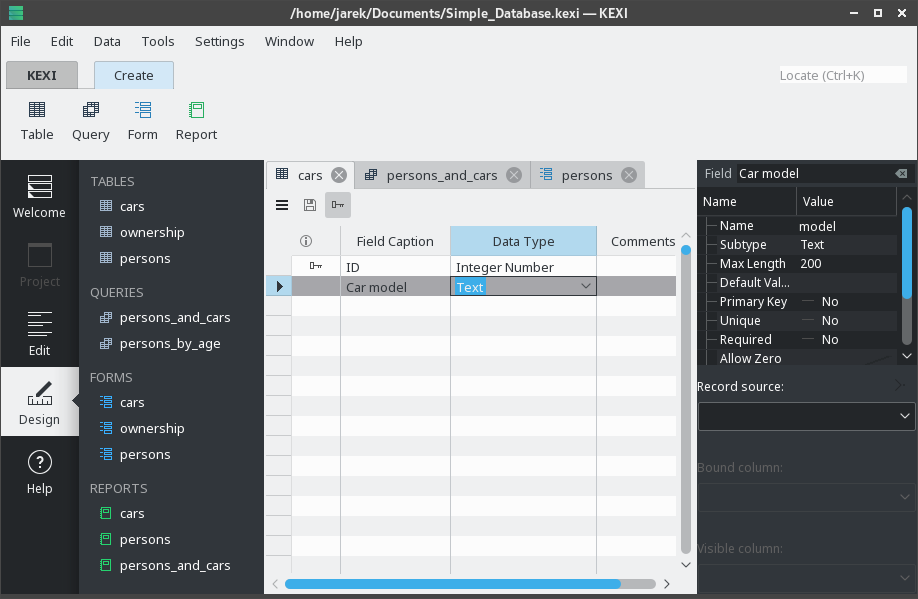Kexi/Handbook/Kexi Basics/The Kexi Main Window/da: Difference between revisions
Importing a new version from external source |
Importing a new version from external source |
||
| Line 19: | Line 19: | ||
;Feltet Projektnavigator | ;Feltet Projektnavigator | ||
:Indeholder en liste over objekter (tabeller, forespørgsler, formularer, ...), som er lavet i det aktuelt åbnede databaseprojekt. Navigatoren har også en lille værktøjslinje med de nyttigste kommandore, som har med databaseobjekter at gøre. | :Indeholder en liste over objekter (tabeller, forespørgsler, formularer, ...), som er lavet i det aktuelt åbnede databaseprojekt. Navigatoren har også en lille værktøjslinje med de nyttigste kommandore, som har med databaseobjekter at gøre. | ||
; | ;Området for åbnede databaseobjekter i faneblade | ||
: | :Et centralt område i programmet, som optager det meste af skærmpladsen. I brugerfladetilstanden IDEAL indeholder det faneblade, som kan flyttes rundt imellem hinanden med vinduer, som altid er maksimerede. I underrammetilstand indeholdet det flydende vinduer. | ||
;Property Editor pane | ;Property Editor pane | ||
:Contains a list of properties of currently activated database object. For certain objects (e.g. form's widgets) it can have several tabs. | :Contains a list of properties of currently activated database object. For certain objects (e.g. form's widgets) it can have several tabs. | ||
Revision as of 17:06, 17 March 2012
Kexis hovedvindue

Værktøjslinjen med faneblade for oven giver adgang til almindelige handlinger og kommandoer.
Projektnavigatoren og Egenskabseditoren vises i felter på hver side af undervinduet. Drres størrelse kan ændres efter behov. Et felt kan skjules ved at klikke på det lille kryds øverst i feltet (lige under værktøjslinjen).
Databaseobjekter (tabeller, forespørgsler osv.) som findes i listen i Projektnavigatoren kan åbnes ved at klikke på deres navn (eller dobbeltklikke, afhængigt af dine globale indstillnger af KDE).
De vigtigste elementer i programmet
De vigtigste elementer i Kexis vindue er:
- Værktøjslinjen med faneblade
- Indeholder programmets tilgængelige kommandoer. Du finder detaljerede beskrivelser af enhver af disse kommandoer i appendikset.
- Feltet Projektnavigator
- Indeholder en liste over objekter (tabeller, forespørgsler, formularer, ...), som er lavet i det aktuelt åbnede databaseprojekt. Navigatoren har også en lille værktøjslinje med de nyttigste kommandore, som har med databaseobjekter at gøre.
- Området for åbnede databaseobjekter i faneblade
- Et centralt område i programmet, som optager det meste af skærmpladsen. I brugerfladetilstanden IDEAL indeholder det faneblade, som kan flyttes rundt imellem hinanden med vinduer, som altid er maksimerede. I underrammetilstand indeholdet det flydende vinduer.
- Property Editor pane
- Contains a list of properties of currently activated database object. For certain objects (e.g. form's widgets) it can have several tabs.
Tabbed Toolbar
The toolbar is the place that gives you access to most Kexi commands and actions. Using the the actions found in the different tabs on the toolbar you can:
- Create / Open / Close Kexi projects
- Create Database objects
- Import / Export Data
- Create widgets on your Forms
- Create widgets on your Reports
The Project Navigator pane is one of the most frequently used elements of the Kexi main window. The pane contains a list of all objects created within the currently opened Kexi database project. The objects are split into groups: tables, queries, forms, reports and scripts.
The Project Navigator pane also contains a small toolbar for most frequently used commands (from left to right): selected object, selected object, and selected object.
For each object on the list a context menu is available using the right mouse button.
Double clicking with the left mouse button on the object's name on the list opens the object in Data View. If the object's window was already opened, the action just activates the window without switching it's view mode.
Opened database objects area / Tabbed Windows
Whenever you double click an object in the project navigator, it opens in the Opened database objects area. Each window has its own tab in Kexi.
You can rearrange the tabs by drag and drop and close them using the close tab button located at the far right of the tab strip.
Property Editor pane
In the Property Editor pane you can change properties of the object displayed in the active window. Depending on the context, the pane is consisted of one or more tabs. The first, always visible tab, , contains the list of available properties.
Rules for using the Property Editor:
- Each row contains a single property.
- You can use the mouse or the keyboard to change values of particular properties.
- Most frequently used types of property values are:
- a number; you can enter the value directly or increase or decrease its value by clicking with the left mouse button on the arrows.
- text
- drop down list of values
- Yes/No; you can toggle the value by clicking on the button; Yes (true) means that the button is toggled on, No (false) means that the button is toggled off.
The Property Editor pane is empty if:
- no single database object's window is opened, or
- the active database object's window does not offer properties; it is usually the case when it is opened in Data View instead of Design View.

